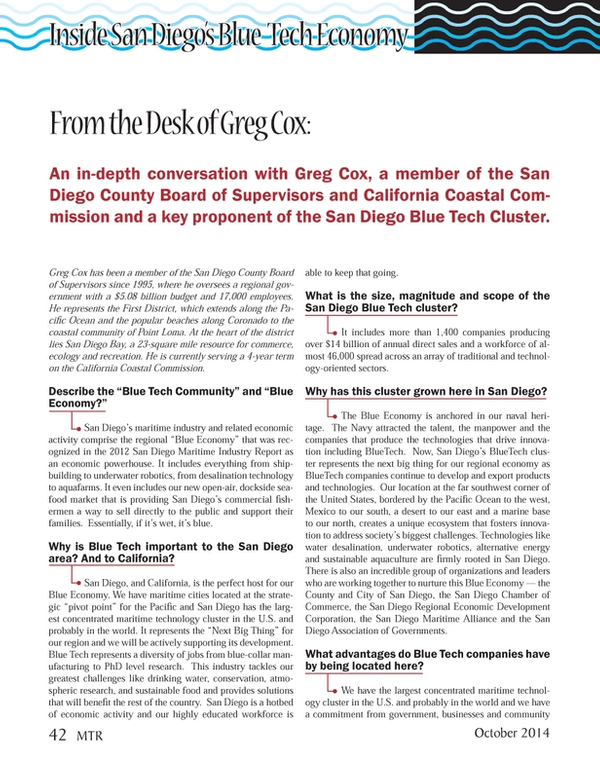
Greg Cox on San Diego's Blue Tech Cluster
An in-depth conversation with Greg Cox, a member of the San Diego County Board of Supervisors and California Coastal Commission and a key proponent of the San Diego Blue Tech Cluster.
Greg Cox has been a member of the San Diego County Board of Supervisors since 1995, where he oversees a regional government with a $5.08 billion budget and 17,000 employees. He represents the First District, which extends along the Pacific Ocean and the popular beaches along Coronado to the coastal community of Point Loma. At the heart of the district lies San Diego Bay, a 23-square mile resource for commerce, ecology and recreation. He is currently serving a 4-year term on the California Coastal Commission.
Describe the “Blue Tech Community” and “Blue Economy?”
San Diego’s maritime industry and related economic activity comprise the regional “Blue Economy” that was recognized in the 2012 San Diego Maritime Industry Report as an economic powerhouse. It includes everything from shipbuilding to underwater robotics, from desalination technology to aquafarms. It even includes our new open-air, dockside seafood market that is providing San Diego’s commercial fishermen a way to sell directly to the public and support their families. Essentially, if it’s wet, it’s blue.
Why is Blue Tech important to the San Diego area? And to California?
San Diego, and California, is the perfect host for our Blue Economy. We have maritime cities located at the strategic “pivot point” for the Pacific and San Diego has the largest concentrated maritime technology cluster in the U.S. and probably in the world. It represents the “Next Big Thing” for our region and we will be actively supporting its development. Blue Tech represents a diversity of jobs from blue-collar manufacturing to PhD level research. This industry tackles our greatest challenges like drinking water, conservation, atmospheric research, and sustainable food and provides solutions that will benefit the rest of the country. San Diego is a hotbed of economic activity and our highly educated workforce is able to keep that going.
What is the size, magnitude and scope of the San Diego Blue Tech cluster?
It includes more than 1,400 companies producing over $14 billion of annual direct sales and a workforce of almost 46,000 spread across an array of traditional and technology-oriented sectors.
Why has this cluster grown here in San Diego?
The Blue Economy is anchored in our naval heritage. The Navy attracted the talent, the manpower and the companies that produce the technologies that drive innovation including BlueTech. Now, San Diego’s BlueTech cluster represents the next big thing for our regional economy as BlueTech companies continue to develop and export products and technologies. Our location at the far southwest corner of the United States, bordered by the Pacific Ocean to the west, Mexico to our south, a desert to our east and a marine base to our north, creates a unique ecosystem that fosters innovation to address society’s biggest challenges. Technologies like water desalination, underwater robotics, alternative energy and sustainable aquaculture are firmly rooted in San Diego. There is also an incredible group of organizations and leaders who are working together to nurture this Blue Economy — the County and City of San Diego, the San Diego Chamber of Commerce, the San Diego Regional Economic Development Corporation, the San Diego Maritime Alliance and the San Diego Association of Governments.
What advantages do Blue Tech companies have by being located here?
We have the largest concentrated maritime technology cluster in the U.S. and probably in the world and we have a commitment from government, businesses and community leaders to support and develop our Blue Economy. San Diego is a strategic military base as we focus more on security concerns in the Pacific, and we have the largest concentration of military personnel in the world. We have a highly educated workforce thanks to leading universities and research institutions. We have the Scripps Institution of Oceanography; a world-renowned oceanographic research institute.
How can someone engage in the San Diego Blue Tech cluster?
Get involved with The Maritime Alliance. They have been the main driver of our civic conversation about the Blue Economy and they have the resources to help local companies.
(As published in the October 2014 edition of Marine Technology Reporter - http://www.marinetechnologynews.com/Magazine)
Read Greg Cox on San Diego's Blue Tech Cluster in Pdf, Flash or Html5 edition of October 2014 Marine Technology
Other stories from October 2014 issue
Content
- Hybrid-Powered Research Vessel Christened page: 16
- What's New in Floating Production Systems? page: 20
- The Road to Standardization page: 22
- Global Navy Power & Changing Paradigm of Submarine Programs page: 26
- Broadband Seismic for Enhanced Pre-salt Imaging page: 30
- Blue Tech Economic Engine Shifts into High Gear page: 40
- Greg Cox on San Diego's Blue Tech Cluster page: 42
- Scripps' San Diego Advantage page: 44
- Teledyne Impulse: Making Connections in San Diego page: 46
- Ocean Aero All About Ocean Observation page: 48
- Rayotek: Seeing Under Pressure page: 50
- SeaBotix: Mini-ROVs Sized Just Right for a Niche Market page: 51
- Xodus Subsea: New Era of Subsea Engineering Support page: 56
- Kongsberg Maritime 3D Monitoring page: 58
- Subsea Camera with Optical & Digital Zoom page: 58
- Woods Hole Selects Rapp CTD Winch page: 58
- Underwater Housing from Gates page: 58
- Bowtech Lamp Range Extended page: 59
- Hydro-Lek Manipulators on Italian Navy ROV page: 59
- Contact Rationalizing and Map Corrections Software page: 59
- SBG Miniature Inertial Sensors page: 59


